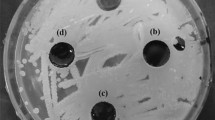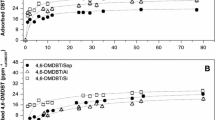Abstract
Biodesulfurization (BDS) in a bioreactor packed with a catalytic bed of silica containing immobilized Rhodococcus rhodochrous was studied. Various bed lengths and support particle sizes were evaluated for BDS of dibenzothiophene (DBT) and gas oil. The sulfur-containing substrates were introduced separately into the bioreactor at different feed flows. Higher removal of sulfur from DBT and gas oil was achieved with a long bed, lower substrate flow, and larger sizes of immobilization particles. The packed bed bioreactor containing metabolic active cells was recycled and maintained BDS activity.
Similar content being viewed by others
Explore related subjects
Discover the latest articles, news and stories from top researchers in related subjects.Avoid common mistakes on your manuscript.
Introduction
Biodesulfurization (BDS) is an environmentally-friendly, microbial technology aimed at decreasing contamination from fossil fuels (Monticello 2000; Li et al. 2008; Noda et al. 2008). For a maximal contact between reaction phases and improved bioavailability of sulfur substrates, the BDS process involves either suspension of whole cells in liquid phases or their immobilization in binding carriers by physical adsorption (Setti et al. 1997) or encapsulation (Gill and Ballesteros 2000). Bacterial immobilization by adsorption using inorganic materials such as alumina, Celite, silica, and sepiolite is more efficient for BDS because diffusional internal restrictions on the mass transfer of substrate and products are avoided (Dinamarca et al. 2010; Naito et al. 2001). Despite this, few studies have applied immobilization by adsorption in experimental bioreactors. In this work, we evaluated the effects on inorganic material of BDS operational variables in a packed bed bioreactor containing immobilized Rhodococcus rhodochrous.
Materials and methods
Bacterial strain, sulfur organic compounds, and materials supports
Rhodococcus rhodochrous (ATCC 53968) was grown in sulfur-free Medium A (Maghsoudi et al. 2001) containing sodium succinate (30 mM) and citrate (0.1 % w/v) as the energy and carbon sources, respectively. 0.0623 M dibenzothiophene (DBT) (Merck) was used as the only sulfur source and gas oil, containing 4.7 g sulfur l−1, and was obtained from Enap (Empresa Nacional del Petróleo de Chile). Silica (BASF) with a specific surface area of 80 m2 g−1 was used as an inorganic support.
In situ cells immobilization
Bacteria were collected by centrifugation at 4000×g for 30 min at 4 °C. The pellet was suspended in 1000 ml 0.85 % w/v NaCl at pH 5.5. For immobilization, the cells were circulated through the packed bed in a downward direction at 10 ml min−1 for 72 h. Bacterial numbers were adjusted by measuring the OD600 and normalized by the mass of support (g) in the catalytic bed. The cell numbers adsorbed were in the range of 74–95 OD600. To remove the non-adsorbed bacteria on the support, saline solution was circulated through the catalytic bed.
Bioreactor operation for biodesulfurization
A glass bioreactor of 125 ml total volume (2 cm diam., 40 cm length) was constructed. The bioreactor was continuously sparged with air at 70 ml min−1 in an upward direction. Feed flow rate of sulfured substrates was provided by a peristaltic pump. The temperature inside the bioreactor was maintained at 20 °C by a thermostatically-controlled water bath. The bioreactor was filled with silica particles to evaluate three packed bed heights (5, 10, and 15 cm) for each of two particles size (0.71–1.18 mm or 3.35–5.6 mm). DBT or gas oil was fed continuously into the packed bed bioreactor in a downward direction at 0.45 or 0.9 ml min−1. The variable packed bed heights and the flow rates used enabled us to determine the effect of retention time (Table 1). The desulfurized substrate was collected after 2 h trickling operation. Samples were taken over 1 h at intervals of 20 min to confirm steady-state operation. As a control, DBT and gas oil were fed into the packed bed without immobilized bacteria.
Recycling of the biocatalyst
After each BDS run, the bed was washed with saline solution and then a fresh bacterial suspension was circulated through the packed bed. This procedure was considered as one cycle of reaction.
Analytical methods
DBT and the total sulfur content in the gas oil were analyzed following the methods described in previous work (Dinamarca et al. 2010). BDS was expressed as BDS (%) = [(S0 − S)/S0] × 100. Experimental data were statistically analyzed by analysis of variance and Fisher least significant difference tests. Each experiment was repeated at least three times.
Results and discussion
The effect of retention time
The effects of different bed lengths on the BDS of DBT and gas oil are shown in Fig. 1a and b. Results indicate that the BDS of DBT was dependent on the length of the bed. The conversion at a flow rate of 0.45 ml min−1 and bed length of 15 cm was 57 %, whereas lengths of 10 and 5 cm gave 41 and 16 %, respectively, at the same flow rate. With a constant flow, it is clear that a greater length of the bed results in a higher retention time (Table 1), allowing a sufficient contact time for expression of the absorbed bacterial metabolism. Similar to the BDS of DBT, sulfur removal from gas oil was greater using a larger bed length (Fig. 1b). However, BDS conversion values were lower for gas oil than for DBT in all the studied systems. It is possible that the presence of organic molecules in gas oil affects the bacterial metabolism and therefore the BDS process (Dinamarca et al. 2014).
BDS of DBT (a) and gas oil (b) in systems with different bed length (5, 10, and 15 cm), two substrate flows rate (0.45 and 0.9 ml min−1), and particle size of 3.35–6.5 mm, using a packed bed bioreactor containing a bed of bacterial cells immobilized on silica. The control was BDS on a packed bed of silica without bacterial cells. Data are reported as the mean of three independent assays. Error bars correspond to the standard deviation
At all bed lengths used, BDS of both sulfur-containing substrates was higher with increased retention time and therefore contact with metabolically-active, immobilized bacterial cells in the biocatalytic bed was doubled (Table 1). This condition was obtained when a low flow rate was used (Fig. 1a, b).
The effect of particle size
The results reported in Fig. 2 show the dependence of BDS on the silica particle size used for cell adsorption. Degradation of DBT was improved when particles of silica in the range of 3.35–5.6 mm were used to absorb cells. Because BDS of DBT with Rhodococcus is a process that depends on the aeration variable (Del Olmo et al. 2005), the results suggest that higher particle size improves aeration of the bed by offering a greater inter-particle volume that can be occupied by both liquid and air. The effect of a large particle size dominates over the higher specific area for cell immobilization offered by a smaller particle size, and shows the importance of the meso- and macro-porosity of the catalytic bed in the configuration of packed bed bioreactors for BDS.
BDS of DBT of systems with a bed length of 15 cm, two substrates, and flow rates, 0.45 and 0.9 ml min−1 for two different particle size ranges (0.71–1.18 and 3.35–5.60 mm), using a packed bed bioreactor containing a bed of bacterial cells immobilized on silica. Data are reported as the mean of three independent assays. Error bars correspond to the standard deviation
Recycling of the biocatalyst
Figure 3 shows values for BDS of gas oil with respect to reaction cycles, using the most efficient conditions identified. The results show that immobilized R. rhodochrous cells maintained BDS activity after three cycles, retaining at least 84 % of the initial desulfurization conversion.
Conversion values of BDS for gas oil from three continuous cycles of reactions carried out on the biocatalytic system recycled in situ, using the most efficient conditions (particle size range 3.35–5.6 mm; bed length 15 cm; substrate flow rate 0.45 ml min−1). Maximum BDS corresponds to conversion of gas oil obtained using the most efficient conditions. Error bars correspond to the standard deviation
The BDS process is affected by sulfur content, the type of hydrocarbon matrix from petroleum (gasoil, diesel, and crude oil refinery products), the active metabolism of known microorganisms, and by the interactions amongst these elements. Reports on BDS of gas oil using batch processes (airlift and stirred tank bioreactors) show sulfur removal values of 50 and 67 % over 30 and 24 h, respectively (Irani et al. 2011; Folson et al. 1999). Conversely, in a continuous system using Rhodococcus globerulus in a two-layer, organic-water, stirred tank, the BDS from diesel was 12 % (Yang et al. 2007). The result of our packed trickle bed reactor (giving a BDS of 18 % at the highest retention time) is satisfactory for sulfur removal from petroleum products with high sulfur content. In contrast to processes using two oil–water phases, the BDS operating with a packed bed containing immobilized bacteria on inorganic material comprises a simple and effective process, with regeneration of the catalytic bed for cyclic operation.
Conclusions
A packed bed bioreactor containing a catalytic bed of immobilized bacteria on Si particles, continuously fed with sulfur-containing substrates, is an effective system for the gas oil BDS process. This study showed that retention times and improved aeration conditions were important for achieving a high conversion of DBT and gas oil. Using the ideal conditions identified, we demonstrated that the biocatalyst could be recycled in situ.
References
Del Olmo C, Santos V, Alcon A, Garcia-Ochoa S (2005) Production of a Rhodococcus erythropolis IGTS8 biocatalyst for DBT biodesulfurization: influence of operational conditions. Biochem Eng J 22:229–237
Dinamarca MA, Ibacache-Quiroga C, Baeza P, Galvez S, Villarroel M, Olivero P, Ojeda J (2010) Biodesulfurization of gas oil using inorganic supports biomodified with metabolically active cells immobilized by adsorption. Bioresour Technol 101:2375–2378
Dinamarca MA, Rojas A, Baeza P, Espinoza G, Ibacache-Quiroga C, Ojeda J (2014) Optimizing the biodesulfurization of gas oil by adding surfactants to immobilized cell systems. Fuel 116:237–241
Folson B, Schieche D, Digrazia P, Werner J, Palmer S (1999) Microbial desulfurization of alkylated dibenzothiophenes from hydrodesulfurized middle distillate by Rhodococcus erythropolis I-19. Appl Environ Microbiol 65:4967–4972
Gill I, Ballesteros A (2000) Bioencapsulation within synthetic polymers (Part 1): sol-gel encapsulated biologicals. Trends Biotechnol 18:282–296
Guo-Qiang Li, Li Li Shan-Shan, Shi-Wei Qu, Qing-Kun Liu, Ting Ma, Lin Zhu, Liang Liang Feng-Lai, Ru-Lin Liu (2008) Improved biodesulfurization of hydrodesulfurized diesel oil using Rhodococcus erythropolis and Gordonia sp. Biotechnol Lett 30:1759–1764
Irani Z, Mehrnia M, Yazdian F, Soheily M, Mohebali G, Rasekh B (2011) Analysis of petroleum biodesulfurization in an airlift bioreactor using response surface methodology. Bioresour Technol 102:10585–10591
Maghsoudi S, Vossoughi M, Kheirolomoom A, Tanaka E, Katoh S (2001) Biodesulfurization of hydrocarbons and diesel fuels by Rhodococcus sp. Strain P32C1. Biochem Eng J 8:151–156
Monticello D (2000) Biodesulfurization and the upgrading of petroleum distillates. Curr Opin Biotechnol 11:540–546
Naito M, Kawamoto T, Fujino K, Kobayashi M, Maruhashi K, Tanaka A (2001) Long-term repeated biodesulfurization by immobilized Rhodococcus erythropolis KA2-5-1 cells. Appl Microbiol Biotechnol 55:374–378
Noda K, Kogure T, Irisa S, Murakami Y, Sakata M, Kuroda A (2008) Enhanced dibenzothiophene biodesulfurization in a microchannel reactor. Biotechnol Lett 30:451–454
Setti L, Lanzarini G, Pifferi P (1997) Whole cell biocatalisys for an oil desulfurization process. Fuel Process Technol 52:145–153
Yang J, Hu Y, Zhao D, Wang S, Lau P, Marison I (2007) Two-Layer continuous-process design for the BDS of diesel oils under bacterial growth conditions. Biochem Eng J 37:212–218
Acknowledgment
The authors are grateful to the Chilean government for financial support from CONICYT through FONDECYT grant 1110724.
Author information
Authors and Affiliations
Corresponding author
Rights and permissions
About this article
Cite this article
Alejandro Dinamarca, M., Orellana, L., Aguirre, J. et al. Biodesulfurization of dibenzothiophene and gas oil using a bioreactor containing a catalytic bed with Rhodococcus rhodochrous immobilized on silica. Biotechnol Lett 36, 1649–1652 (2014). https://doi.org/10.1007/s10529-014-1529-y
Received:
Accepted:
Published:
Issue Date:
DOI: https://doi.org/10.1007/s10529-014-1529-y







